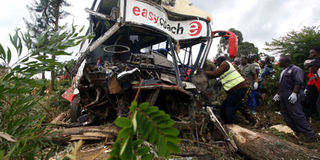NTSA adopts random vehicle inspections to reduce crashes

Rescuers try to free passengers trapped in the wreckage of a bus that was involved in a crash at Sachangwan on October 28, 2016. WHO places Kenya on the list of countries with the most dangerous roads. PHOTO | SULEIMAN MBATIAH | NATION MEDIA GROUP
What you need to know:
- Statistics by NTSA show that 1,852 people suffered serious injuries through road crashes this year.
- The NTSA has listed the Konza-Mtito Andei Road as the riskiest this year, followed by the Eldoret-Nakuru highway.
It is now six years since a bus carrying 71 pupils from Loreto Convent Msongari was involved in a fatal crash on the Meru-Nanyuki highway.
The bus hit another belonging to Kerugoya Boys High School, which had been parked by the roadside.
Two pupils died on the spot and a third lost her life while undergoing treatment.
Many others were seriously injured and got admitted to hospital for a long time.
ADJUSTMENT
Joy Mvatie lost her right arm and Sandra Wambui lost her left.
Even though the two have adapted to the changes in their bodies and even passed their primary and secondary examinations, they had to undergo physical and psychological therapy and learn to live with one hand.
To this day, the July 29, 2011 accident remains etched in their minds.
Joy and Sandra are two of the many crash survivors who continue to pay a personal price for the carnage on Kenyan roads.
PHYSICAL SCARS
Often, attention is paid to those who lose their lives and headlines crafted around casualty figures with little concern to those who survive and how they cope with the trauma and injuries.
Statistics from police and the National Transport and Safety Authority (NTSA) show that 1,852 people suffered serious injuries through road crashes this year.
Another 2,101 suffered slight injuries. All will live their lives with physical and emotional scars.
HIT-AND-RUN
The statistics also show that 217 vehicles involved in crashes in the past five months could not be traced, placing hit-and-run accidents at the top of the list of accident types.
The major causes of crashed were drivers losing control of their vehicles (142), overtaking improperly (118) and misjudging clearance distance (78).
A significant number of accidents — 68 — were attributed to improper use of traffic lanes while walking or running off footpath accounted for 49.
Another 45 were attributed to speeding.
HOT SPOTS
The NTSA has listed the Konza-Mtito Andei Road as the riskiest this year, followed by the Eldoret-Nakuru highway.
The Mlolongo-Konza stretch completes the ignominious three while the Nairobi-Naivasha and Gilgil-Nakuru stretches were fourth and fifth, respectively.
Others are Mtito Andei-Voi, Kilifi-Mombasa, and the Eastern Bypass in Nairobi and the Thika Superhighway.
Last year, the authority had named the Nairobi-Mombasa highway and the Nairobi-Nakuru Road as the stretches with highest fatalities, followed by the Nakuru-Eldoret highway and Thika Superhighway.
VEHICLE INSPECTIONS
From the statistics, 85 buses have been involved in fatal crashes since January 1.
In all, 155 PSVs have been involved in such incidents, so far.
The NTSA director for Road Safety, Ms Njeri Waithaka, said some of the measures that her team is taking to reduce crashes include random motor vehicle inspections and verification of drivers’ licences.
“Dangerous behaviour on the roads drastically increases the risk of a crash,” Ms Waithaka said and cautioned PSV operators to drive carefully during the rainy season.
ROAD DISCIPLINE
Earlier this week, NTSA director-general Francis Meja, announced that the more than two million motorists in the country will from July 1 be required to acquire a new, mandatory sticker.
“The sticker is meant to ensure that vehicle owners acquire the highest standards of discipline on the roads.
"It will also curb the road offences, interchanging of number plates as well as reduce crimes conducted using motor vehicles,” he said.
This year, the National Police Service devolved the Traffic Department and gave powers to County Police Commanders to manage the enforcement of traffic rules.
ALCOBLOW
The move, according to the Inspector General of Police Joseph Boinnet, is meant to reduce accidents by increasing accountability.
Officers in-charge of traffic said the move would enable the counties to point out the problems facing each region.
It will also improve traffic management, which is in turn expected to reduce accidents.
In Nairobi, NTSA says the use of Alcoblow, CCTV cameras and increased enforcement have worked to reduce both fatalities and injuries.
“Our biggest problem is the vehicle volumes in the city and pedestrians crossing at undesignated areas. Also, we have the issue of boda boda riders using the wrong lanes and flouting traffic rules,” Nairobi County Traffic Commander Leonard Katana said.
CRASH SURVIVORS
The World Health Organization (WHO), in its latest report, estimates that out of 100,000 people, 30 die from accidents.
WHO places Kenya on the list of countries with the most dangerous roads.
Significantly, WHO recommended that the country should have official data on road traffic crash survivors with permanent disability.





